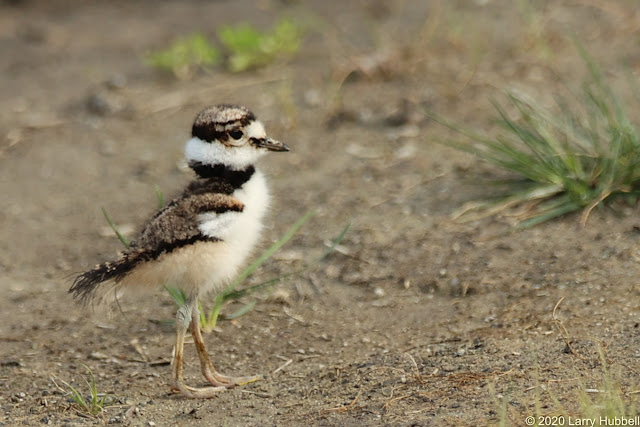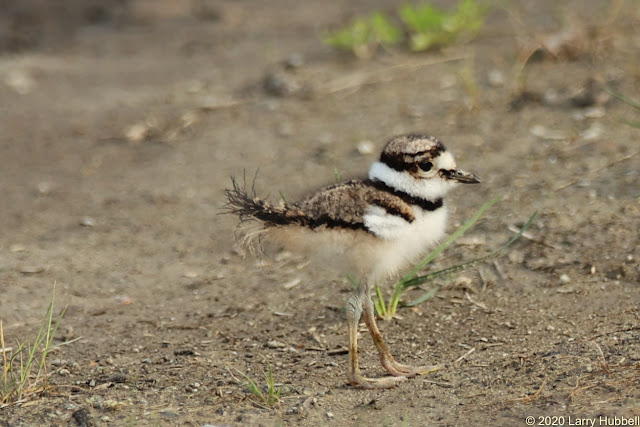When they hatch, their feathers are damp. However, almost as soon as they dry, the chicks are on their feet and...
Although, they are not completely on their own. In this early stage, if a parent senses danger they will call the young and lead them away.
The young chick's downy feathers are so soft, speckled, and fuzzy it can be hard to keep them in focus. Notice the lack of any obvious color surrounding its eye.
Especially, when young their feathering provides critical camouflage as well as warmth.
At 24 hours they can be surprisingly capable, however, they do lack one critical skill. They can not yet fly. In about a month their wings and tails will develop and the sky will become their limit.
This young Killdeer is probably a week or two older than the one above. Its tail is starting to take shape. It may also be developing a second dark band around the neck and upper chest.
The adults and the young look similar, but the number of bands on the upper chest is distinctive.
As the wings develop a young bird will occasionally run, flap, and leap. It can give the appearance of skipping across the ground similar to a smooth stone bouncing across the surface of a pond.
When it stops to stretch a wing it foreshadows a curiously odd adult behavior.
When not nesting or raising young Killdeer will form small groups. Unlike Crows and Coots, they are more socially independent and don't fully form flocks.
When they sense danger they will sometimes fly. While in-flight, their long, counter-shaded, wings provide speed, agility, and a bit of overhead camouflage against a bright sky.
However, like other shorebirds, they are also fast on their feet and sometimes simply run from danger. Most shorebirds, spend the bulk of their time on shores. Killdeer are unique in that they will spend time on large lawns, fields, construction sites, and even parking lots. In year's past, I have even noticed Killdeer running around on the huge asphalt parking lot north of the University of Washington Inter-Mural Activities Center. It is surprising how well their skills adapt to human environmental modifications.
In the photo above, you can also see the bright red coloring that develops on the skin surrounding the eye. Strikingly different than the pale coloring around the eyes of the chicks. I wonder about the purpose of this coloring. I have read that Killdeer also feed at night. Maybe the red coloring somehow helps with their night vision.
When running, they also have the surprising behavior of abruptly coming to a full stop. It seems like, they reevaluate the potential danger versus the energy expenditure. They must have supreme confidence in their ability to take to the air and immediately evade anyone and anything. Their confidence appears completely justified to me.
When nesting or watching over their young the adult's confidence reaches a whole new level. Calling loudly, (which is true to their name, Charadrius vociferus, which essentially means 'noisy plover') they will often run towards potential danger. This precarious approach is not used by many other creatures. They are difficult to ignore, which is precisely the point. While potential predators or large clumsy creatures (like me) are distracted by the adult, the young can quietly escape, also the eggs left behind by the adult simply blend into the background.
Killdeer eggs are sufficiently speckled that they can be virtually impossible to see against a gravel background. I am afraid to walk close to a potential nest. Not only do I not want to disturb the adults but I also doubt my ability to perceive the eggs before stepping on them.
Their eggs are approximately an inch and half long and a little over one inch in diameter. Four eggs appear to be a common brood size. They can also lay multiple broods in a single year.
Note: Thank you to Dennis Paulson and the Slater Museum for allowing me to take photos of their egg collections.
In this photo, I am uncertain whether the adult is teasing me, by acting like it is nesting, or whether we are seeing one of the eggs under its chest. In either case, I imagine this is pretty much what a Killdeer nest looks like. It is just a scrape in the ground with eggs.
Update:
We no longer need to imagine what a killdeer nest looks like.
Yesterday, Sarah Schmidt, sent in this wonderful photo. Last year, while on a walk with friends, they just happened to pass by this beautiful nest full of Killdeer eggs. She carefully and quickly took this photo before leaving the eggs undisturbed.
The adult's ultimate defensive behaviors involve calling loudly while acting like they have a broken wing or flashing their surprisingly distinctive tails. This counter-intuitive behavior works. Killdeer survival rates are probably far better than most other shorebirds.
Their drive for multiple broods is quite strong. While observing the chicks above I noticed two adults getting surprisingly close. The bird on the right is even leaning slightly forward. This behavior might appear to be a bit subtle from a human perspective, however, it is a clear invitation to its mate.
The male and female birds appear to be approximately the same size.
As with the photos of the chicks above this all took place inside the construction area for the 520 bridge. From the bird's perspective, this Spring they were lucky to have a fenced area which is 'off-limits' to humans. It was a bit like a temporary wildlife sanctuary.
During the dismount the male reveals the underside of his surprisingly beautiful and elegant wings.
In this final photo, the male has extended his neck which makes his upper band taller. What surprises me most is how suddenly the male bird also seems larger. Especially, since the female may be closer - compare the location of their legs. Maybe the male has just fluffed up his feathers while taking pride in his accomplishment.
By the way, the name 'Killdeer' does not imply any danger to deer. It is simply the closest human equivalent to the sound of their song. Click Here to hear one of their songs on All About Birds.
Have a great day on Union Bay...where nature lives in the city!
Larry
Going Native:
Without a well-funded Environmental Protection Agency, it falls to each of us to be ever more vigilant in protecting our local environments. Native plants and trees encourage the largest diversity of lifeforms because of their long intertwined history with our local environment and native creatures. I have been told that even the microbes in the soil are native to each local landscape. I hope we can inspire ourselves, our neighbors and local businesses to respect native flora and to support native wildlife at every opportunity. I have learned that our most logical approach to native trees and plants (in order of priority) should be to:
1) Learn and leave established native flora undisturbed.
2) Remove invasive species and then wait to see if native plants begin to grow without assistance. (If natives plants start on their own, then these plants or trees are likely the most appropriate flora for the habitat.)
3) Scatter seeds from nearby native plants in a similar habitat.
4) If you feel you must add a new plant then select a native plant while considering how the plant fits with the specific habitat and understanding the plant's logical place in the normal succession of native plants.
My intention in my weekly post is to include at least one photo each week and visually challenge us to know the difference between native and non-native lifeforms.
By the way, my friend Tom Brown pointed out that the application named 'Wildflower Search' is extremely helpful. Click on the highlighted link to see for yourself.
By the way, my friend Tom Brown pointed out that the application named 'Wildflower Search' is extremely helpful. Click on the highlighted link to see for yourself.
Scroll down for the answer.
***************
Orange Honeysuckle: I am always surprised to find this beautiful and exotic looking flower is a PNW native.
***************
Over the years I have had many readers tell me that Google is no longer sending them email announcements regarding my posts. Even more frustrating when they go to 're-sign-up', hoping that will enable them to once again start receiving the announcements, they get a message which says 'Sorry, you are already signed up.' Google has not responded to my requests for help with this issue.
My functional workaround is to set up my own email list and each week I manually send out a new post announcement. If you are experiencing the issue and would like to be added to my personal email list please send me an email requesting to be added. Thank you for your patience!
My email address is: LDHubbell@Comcast.Net
***************
The following photos are a little reward for those who read...
...all the way to the end.

































No comments:
Post a Comment